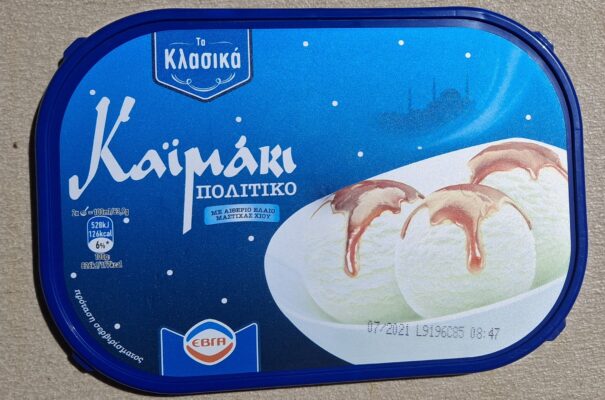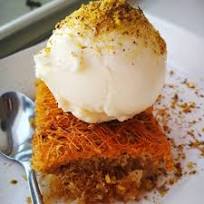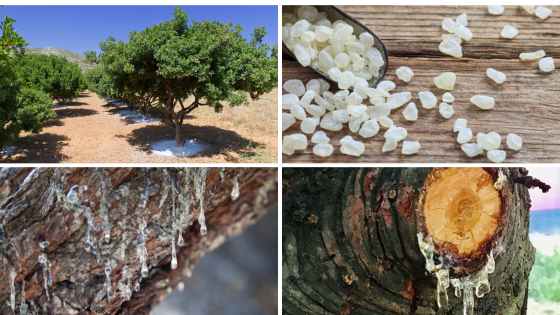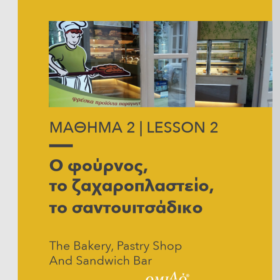Uncategorised
What is Greek kaimaki ice-cream?
What is Greek kaimaki ice-cream?
Well, for sure Italy has delicious ice-cream but the last decade, also Greece became a master in making ice-cream, with natural flavours, biological ice-cream, etc..
Most ice-cream flavours can be found in many countries, but there is one flavour that is typically Greek, and I have never seen anywhere else. This is the so-called “Kaimaki” flavour.
What is kaimaki ice-cream and where you can find it?
Origins and Tradition
Kaimaki ice cream traces its roots back to the Ottoman Empire, where it was first crafted in the imperial kitchens. Its name is derived from the Turkish word “kaymak,”
Kaymak, also spelled as “kaimak,” is a rich, creamy dairy product commonly consumed in several countries in the Middle East, Central Asia, and the Balkans, including Turkey andGreece.
It is made by boiling milk slowly over low heat and allowing it to cool, which causes the cream to rise to the surface. The cream is then skimmed off and allowed to thicken further before being served.
Over the centuries, this delicacy found its way to Greece, where it was embraced and transformed into the beloved dessert we know today.
The Flavor Experience
What sets Kaimaki ice cream apart is its distinctive flavor profile. Unlike traditional ice cream varieties,
Kaimaki is characterized by the addition of mastic resin and salep powder.
Mastic, harvested from the mastic tree on the island of Chios, lends a subtle pine-like aroma and a hint of herbal sweetness to the ice cream.
Salep, derived from the roots of wild orchids, acts as a natural thickener, imparting a luxurious creaminess to the final product.
Most icecream shops in Greece will have the Kaimaki flavour, but you can also find it in any supermarket in Greece.

What is “mastic” of Chios island?
So, Kaimaki ice-cream in Greece, usually has “Mastic of Chios”, which gives the special taste.
Mastic or “masticha,” is a natural resin harvested from the mastic tree, primarily cultivated on the Greek island of Chios.
This unique resin has been prized for its aromatic, therapeutic, and culinary properties for thousands of years.
The mastic tree is native to the Mediterranean region, particularly the island of Chios, where it thrives in the island’s arid climate and rocky terrain.
The process of harvesting mastic is labor-intensive and requires great care and skill. It involves making small incisions in the bark of the mastic tree to allow the resin to ooze out.
The resin then hardens into translucent teardrops or “tears” upon exposure to air.
Once harvested, mastic resin undergoes a cleaning and sorting process. It is then graded according to its size, color, and purity before being packaged for distribution.
Mastic of Chios is renowned for its distinct aroma and flavor, which is characterized by its subtle pine-like scent and refreshing herbal notes.
In addition to its culinary uses, mastic has been valued for its medicinal properties,
with historical references dating back to ancient Greece and beyond. It has been traditionally used to treat ailments such as digestive issues, oral hygiene problems, and skin conditions.
In Greek cuisine, mastic is a prized ingredient, particularly in desserts and confections. It is commonly used to flavor sweets such as ice cream, pastries, and puddings,
adding a unique depth of flavor and aroma. Additionally, mastic resin is used to produce a variety of other products, including chewing gum, tooth paste, liqueurs, and cosmetics.
Overall, mastic of Chios is a treasured natural resource that not only contributes to the culinary richness of Greece but also holds cultural and historical significance as a symbol of the island of Chios’s heritage and traditions.
See below how the mastic tree looks like, as well as the mastic tears
When do Greeks eat Kaimaki ice-cream?
Kaimaki ice cream is very popular to just eat like that, as an ice-cream, but its unique flavor and creamy texture, also goes very well together with a variety of traditional Greek desserts .
Here some examples, or suggestions for you to try!
1. Baklava:
This iconic Greek dessert features layers of phyllo pastry filled with chopped nuts and sweetened with honey or syrup.
The combination of crunchy nuts and syrupy sweetness contrasts wonderfully with the creamy texture of Kaimaki ice cream.
2. Kataifi:
Similar to baklava, kataifi is made with shredded phyllo dough instead of sheets. It is typically filled with nuts, spices, and honey syrup, offering a unique texture and flavor that complements Kaimaki ice cream beautifully.

3. Fresh Fruit:
Seasonal fruits such as figs, strawberries, or oranges can be served alongside Kaimaki ice cream for a refreshing and healthful dessert option.
The natural sweetness of the fruit enhances the overall flavor experience.
Kaimaki is also often consumed in combination with sour cherries

4. Greek Coffee:
To round off the meal, a cup of strong, aromatic Greek coffee pairs perfectly with a serving of Kaimaki ice cream.
The rich flavors of the coffee complement the sweetness of the ice cream, creating a satisfying end to a Greek meal.
These are just a few examples of the delightful combinations that Greeks enjoy with Kaimaki ice cream.
If you want to learn more about all variations of Greek coffee, cold and warm, and how to order them, then this eBooks is useful to have
Do have a sweet tooth, and you would like to try some more Greek sweets?
Then take a look at the special GREEK BAKERY AND PASTRY SHOP lessons. A Multi-media Greek lesson
https://masaresi.com/product/greeklesson-bakery/
Careful ; Do not confuse the words “kamaki” and “kaimaki”
They are 2 completely different things 🙂 Listen to a Greek story, and find out more…
https://masaresi.com/product/easy-greek-story-podcast-notebook-29/




